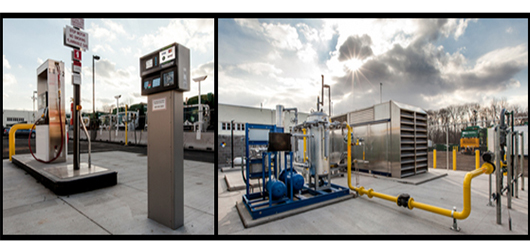Design of compressed natural gas (CNG) fueling stations require the skills of mechanical, electrical, structural and civil engineers as well as architects and surveyors. Unlike traditional gasoline or diesel fueling facilities CNG stations are not “one size fits all” primarily due to the available natural gas pressure and volume of gas that utility companies can provide. CNG fueling station design requires calculating fuel usage in the form of DGE or GGE (diesel gallon equivalent or gasoline gallon equivalent).
Time-fill statio ns are used primarily by commercial fleet vehicles such as collection vehicles and school buses. They work best for vehicles that refuel at the same location every night, also known as “return to base” operations. At a time-fill station, fleet vehicles are filled via a network of pipes and CNG dispensers directly from a compressor on site that is drawing the gas from the natural gas utility and compressing to 3600 psi. The size of the compressor depends on the size of the fleet needing to be filled, the gas pressure available, and volume of gas the utility company can provide. The time necessary to fuel a vehicle will depend on the size of the compressor, the number of vehicles, and how the compression is divided among the vehicles. Fueling is performed overnight when peak usage demands are not placed on the utility companies. Time-fill fueling can take anywhere from a few hours up to 12 hours. Time-fill is also referred to as slow-fill fueling.
ns are used primarily by commercial fleet vehicles such as collection vehicles and school buses. They work best for vehicles that refuel at the same location every night, also known as “return to base” operations. At a time-fill station, fleet vehicles are filled via a network of pipes and CNG dispensers directly from a compressor on site that is drawing the gas from the natural gas utility and compressing to 3600 psi. The size of the compressor depends on the size of the fleet needing to be filled, the gas pressure available, and volume of gas the utility company can provide. The time necessary to fuel a vehicle will depend on the size of the compressor, the number of vehicles, and how the compression is divided among the vehicles. Fueling is performed overnight when peak usage demands are not placed on the utility companies. Time-fill fueling can take anywhere from a few hours up to 12 hours. Time-fill is also referred to as slow-fill fueling.
Electricity usage is also factor in time-fill technology. The compressor is the largest demand on the electrical grid. Demand can vary from a few hundred amps to several thousand amps, depending on the number and size of compressors being used.
Fast-fill stations are suitable as retail fueling stations for light duty vehicles or fleets of vans, pickup trucks, or passenger cars that arrive at various times throughout the day and need to be filled quickly. Similar to time-fill fueling, natural gas is piped from the utility company to the station where it is compressed. The compressor which compresses the gas to 3600 psi can be used as CNG fuel depending on gas pressures from the utility company. Once compressed, the CNG may be stored in large storage tanks under high pressure (4500 psi) to be dispensed, for a quick fill-up when needed. The duration of fast-fill fueling is generally the same as it would be for a gasoline fill, roughly five to seven minutes.
ET Environmental is a leader in CNG design, engineering and construction. ET has constructed over 150 fueling stations and natural gas vehicle maintenance facilities throughout the United States and Canada. Please contact us to learn more.



